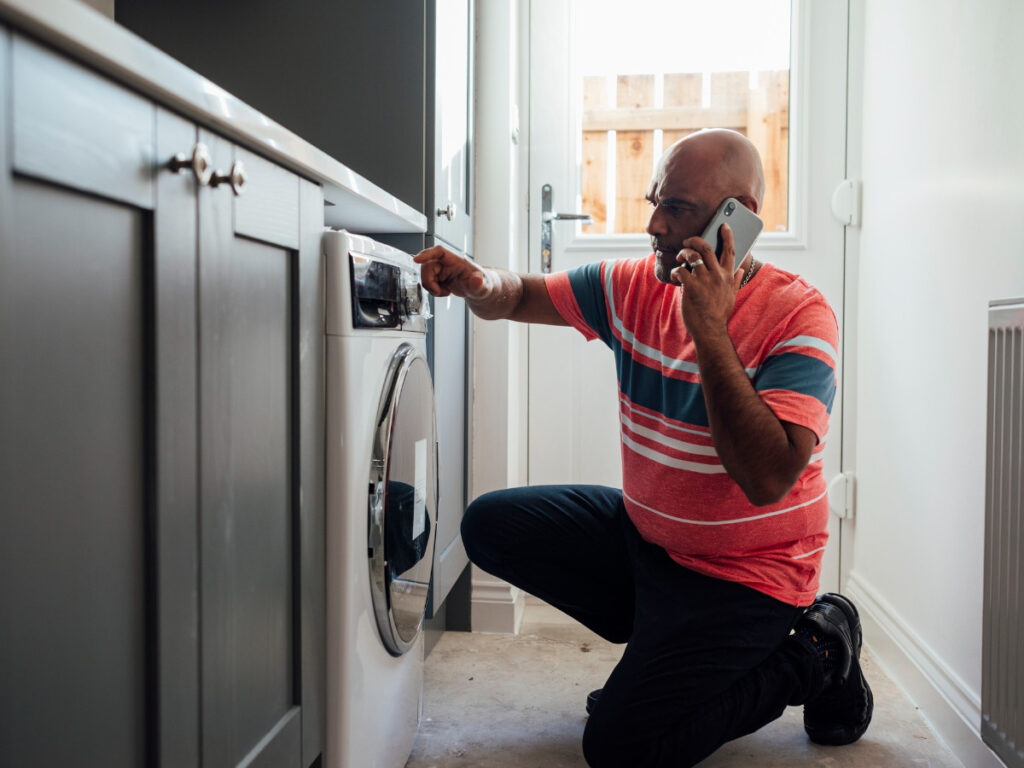You went to do a load of laundry only to find out that your washing machine didn’t fill with water or that it was washing at the wrong temperature. Before your washing machine gets you into “hot water,” learn about common washing machine water issues, how to troubleshoot them, and when it’s time to let your weary washer retire.
1. Your Washer Won’t Fill with Water
We’ve covered why water can get stuck in washing machines, but what happens when you have the opposite problem? Various issues can cause this “no water going into washing machine” problem, from kinks in your water hoses to faulty lid switches.
Check the Water Supply Valves and Hoses
Fortunately, fixing this problem may be as simple as turning a few knobs and straightening out your washer’s water hoses! Pull your machine away from the wall and verify that both your hot and cold water supply knobs are turned on. Then, confirm there are no kinks in the hoses that could restrict water flow. If there are, straighten them out and reposition the hoses. If this doesn’t resolve the problem, try the next troubleshooting step.
Check for Clogs in the Inlet Screens
If your supply knobs were turned to the on position and you didn’t find any kinks, you may want to verify that your lines aren’t blocked. Turn off the water to your machine and disconnect the hoses from the back of your washer to access the inlet screens. If you find any debris, remove the screens and soak them in vinegar to remove any limescale buildup. Give them a quick rinse, reinstall them, reconnect your hoses, and enjoy your operational washing machine!
Check the Machine’s Lid Switch
To prevent soggy situations, your washing machine needs to recognize when its lid is closed. That’s where lid switches come in! When depressed, the lid switch tells the washer it’s closed and ready to start. If this switch fails to activate, your washing machine may refuse to fill up or start, since it believes the lid is still open. Since switches can fail physically or electronically, there are two ways to troubleshoot them.
Physical Lid-Switch Issues
First, check that the switch hasn’t failed physically by locating the switch and depressing it manually. The location of your lid switch can vary, depending on which type you have. But generally, the lid switch can be found underneath your top loader’s lid. If the switch doesn’t provide any resistance when depressed, its internal spring may have failed.
Electronic Lid-Switch Issues
If the switch does provide resistance, but your washer still won’t start, you may have an electronic issue. Troubleshooting electronic failure takes a few more tools and is a bit more hands-on, but it is still doable!
First, unplug the washer for your safety. Then, access the switch by removing the top panel of your machine. From there, you’ll need to remove the switch from the machine and test its continuity with a multimeter. Put your multimeter in the lowest ohm setting and connect its probes to the non-ground wires running into the switch. With the probes connected, depress the switch and verify that the circuit has continuity. If it doesn’t, you’ve found the culprit of your washer woes!
2. Your Washing Machine Only Has Hot Water
If your washing machine has no cold water, it could be due to closed water valves, clogged inlet filters, or kinked hoses. However, if you’ve recently moved your washing machine or installed a new one, the hoses for hot and cold may be connected to the wrong ports on the back of the machine. If that’s the case, it’s an easy fix — simply swap the hoses around to fix your problem!
3. Your Washing Machine Only Has Cold Water
Troubleshooting for a washing machine with no hot water is similar to one not receiving any cold water. Closed water valves, clogged inlet filters, or kinked hoses could all be the culprit.
However, since water is generally heated externally, it takes some time for hot water to be delivered to your washing machine from your water heater. If you check the water temperature at the beginning of the washer’s cycle, the water may not be hot yet. So, check back later in the cycle to verify there is a problem.
If the hot water is not working on the washing machine after troubleshooting, one of its many electrical components may have failed. In that case, it might be time to call an appliance repair service or consider replacing your unit.
Still Having Issues? Let Rent-A-Center Help!
Is your washing machine ready to throw in the towel? Or maybe, it’s too costly to repair. It might be time to consider a washing machine replacement.
Fortunately, Rent-A-Center has affordable rent-to-own options for Whirlpool washing machines and laundry sets. Not only will you get a reliable and efficient washer, but you’ll also enjoy the benefits of a new appliance, including the latest features and technologies like Whirlpool Active Bloom™, which helps you save money by adapting water levels according to load size.
Read our guide on how to pick out a new washer and dryer, and shop online or stop by your nearest Rent-A-Center location today.

